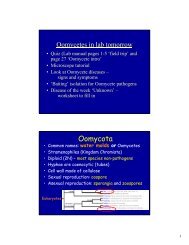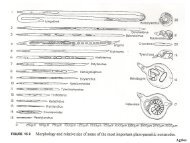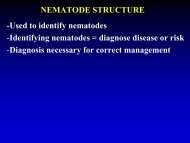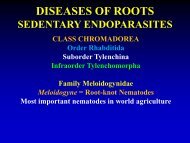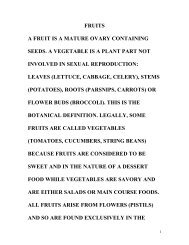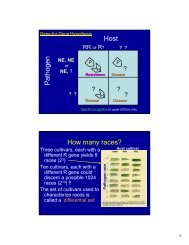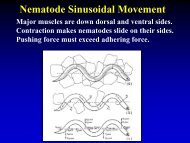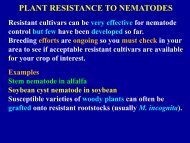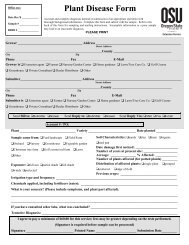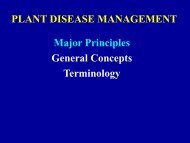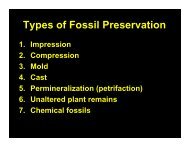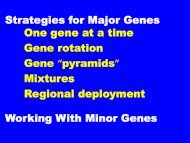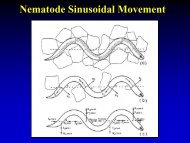DISEASES OF ROOTS MIGRATORY ECTOPARASITES
DISEASES OF ROOTS MIGRATORY ECTOPARASITES
DISEASES OF ROOTS MIGRATORY ECTOPARASITES
You also want an ePaper? Increase the reach of your titles
YUMPU automatically turns print PDFs into web optimized ePapers that Google loves.
<strong>DISEASES</strong> <strong>OF</strong> <strong>ROOTS</strong><br />
<strong>MIGRATORY</strong> <strong>ECTOPARASITES</strong><br />
-Most common type of plant parasitic nematode<br />
-Life cycles simple and similar<br />
-Most genera have many species<br />
-Most have wide host ranges<br />
-Pathology similar but severity and thresholds vary<br />
-Nematicides primary control measure, if available
<strong>MIGRATORY</strong> <strong>ECTOPARASITES</strong><br />
LIFE CYCLE
<strong>DISEASES</strong> <strong>OF</strong> <strong>ROOTS</strong><br />
<strong>MIGRATORY</strong> <strong>ECTOPARASITES</strong><br />
CLASS CHROMADOREA<br />
Order Rhabditida<br />
Suborder Tylenchina<br />
Infraorder Tylenchomorpha<br />
Family Dolichodoridae<br />
Dolichodorus = “awl” nematodes, 16 species<br />
Based on shape of stylet
<strong>DISEASES</strong> <strong>OF</strong> <strong>ROOTS</strong><br />
<strong>MIGRATORY</strong> <strong>ECTOPARASITES</strong><br />
CLASS CHROMADOREA<br />
Order Rhabditida<br />
Suborder Tylenchina<br />
Infraorder Tylenchomorpha<br />
Family Dolichodoridae<br />
Belonolaimus = 10 species<br />
Belonolaimus longicaudatus = “sting” nematode
*<br />
Agrios
Belonolaimus<br />
Female Tail<br />
Dolichodorus<br />
Female Tail<br />
Belonolaimus<br />
Male Tail<br />
Dolichodorus<br />
Male Tail
Belonolaimus longicaudatus = sting nematode<br />
Life cycle and biology<br />
- The most damaging migratory ectoparasite.<br />
- Very serious on a wide variety of crops in the<br />
southeastern US = corn and many other vegetables,<br />
cotton, peanuts, soybean, turf and pasture grasses,<br />
forest trees.<br />
- Most prominent in warm sandy (80%) soils where<br />
they can completely destroy a crop.<br />
- Life cycle is about 4 weeks.
Belonolaimus longicaudatus = sting nematode<br />
Stylet thrusts deep<br />
into roots<br />
= local lesions<br />
Soybean<br />
Stubby or coarse roots<br />
may be present<br />
L.I. Miller<br />
Nemapix 1
Belonolaimus longicaudatus = sting nematode<br />
-Feed on root tips or<br />
on sides of root.<br />
-Feeding on one side<br />
stops growth, other side<br />
continues to grow<br />
so root curves.<br />
Soybean<br />
L.I. Miller<br />
Nemapix 1
Belonolaimus longicaudatus = sting nematode<br />
Plants wilt, appear chlorotic and are reduced in size.<br />
In severe infestations the entire crop may die.<br />
L.I. Miller<br />
Nemapix 1
Belonolaimus longicaudatus = sting nematode<br />
Symptoms<br />
- Root system is greatly reduced,<br />
- Increase in lateral root production = "blind root tip"<br />
- Secondary invasion my other bacteria and fungi<br />
Interacts with Fusarium on cotton.<br />
- Water and nutrient uptake are greatly reduced.
Belonolaimus longicaudatus = sting nematode<br />
Control<br />
Physical incorporation of nonfumigant granular<br />
nematicides (aldicarb, carbofuran, dasanit).<br />
Soil fumigation<br />
Up to 500% yield<br />
increases have been<br />
reported when<br />
controlled.<br />
Cabbage<br />
SON<br />
Nemapix 1
<strong>DISEASES</strong> <strong>OF</strong> <strong>ROOTS</strong><br />
<strong>MIGRATORY</strong> <strong>ECTOPARASITES</strong><br />
CLASS CHROMADOREA<br />
Order Rhabditida<br />
Suborder Tylenchina<br />
Infraorder Tylenchomorpha<br />
Family Dolichodoridae<br />
Tylenchorhynchus = “stunt” nematodes, 130+ species<br />
Several morphologically similar genera, 250+ species
*<br />
Agrios
Tylenchorhynchus sp.<br />
U. Zunke<br />
Nemapix 2
Tylenchorhynchus = stunt nematode<br />
Life cycle and biology<br />
-Common on roots of many plants.<br />
-Feed on epidermal cells in the region of root elongation<br />
and region of root hairs<br />
- Rarely important unless in very high numbers<br />
such as tobacco, turf grasses, pastures, corn.<br />
- Common in grassland and rangeland.<br />
- Can be serious on azaleas, African violet, pines<br />
Symptoms<br />
Large numbers debilitate roots, tops become stunted and<br />
chlorotic, and yield may be reduced<br />
Control<br />
Nematicides
<strong>DISEASES</strong> <strong>OF</strong> <strong>ROOTS</strong><br />
<strong>MIGRATORY</strong> <strong>ECTOPARASITES</strong><br />
CLASS CHROMADOREA<br />
Order Rhabditida<br />
Suborder Tylenchina<br />
Infraorder Tylenchomorpha<br />
Family Hoplolaimidae<br />
Hoplolaimus = “lance” nematodes, 30+ species
*<br />
Agrios
Hoplolaimus<br />
1-2 mm in length
Hoplolaimus = “lance” nematodes<br />
Life cycle and biology<br />
-Usually ectoparasites but sometimes may be found<br />
partly or entirely within root tissues<br />
= semi-endoparasite -> endoparasite.<br />
- May be ectoparasite on young roots and endoparasite<br />
on older roots.<br />
- Life cycle can be 6-7 weeks.<br />
- In high populations may damage many different crops;<br />
grasses, cotton, pine, oak, wheat, banana, sugarcane,<br />
corn, soybean, coffee, tea, turf and forest trees.
Hoplolaimus = “lance” nematodes<br />
Life cycle and biology<br />
- Nematode kills cells of cortex or of the vascular tissue<br />
=> extreme necrotic lesions extending to cells some<br />
distance beyond those directly adjacent to the parasite.<br />
Extensive invasion results in destruction of large areas<br />
of root including phloem and xylem tissues.<br />
Can impede mycorrhizal associations of pine trees,<br />
which are essential for the normal growth of trees.
Hoplolaimus = “lance” nematodes<br />
Symptoms<br />
- Stunting, chlorosis, wilting, yield reduction.<br />
- Yellow, red or brown necrotic areas on root<br />
=> depends on density and/or the duration of feeding.<br />
- Holes in cortex
Stunting and chlorosis of soybean caused by lance<br />
nematode, Hoplolaimus columbus<br />
S. Koenning<br />
Nemapix 2
Hoplolaimus = “lance” nematodes<br />
Control<br />
- Soil fumigation<br />
- Nematicides<br />
- Dips for sprigs of Bermuda grass.<br />
- Fallowing may help but H. columbus survived storage<br />
in dry soil for 5 years.
<strong>DISEASES</strong> <strong>OF</strong> <strong>ROOTS</strong><br />
<strong>MIGRATORY</strong> <strong>ECTOPARASITES</strong><br />
CLASS CHROMADOREA<br />
Order Rhabditida<br />
Suborder Tylenchina<br />
Infraorder Tylenchomorpha<br />
Family Hoplolaimidae<br />
“Spiral Nematodes”<br />
Scutellonema spp.<br />
Rotylenchus spp. – 80+ species<br />
Helicotylenchus spp. – 160+ species
*<br />
Agrios
Scutellonema<br />
Life cycle and biology<br />
- Feed as ectoparasites on roots of cotton, coconut,<br />
banana, corn, ornamentals, peanut.<br />
- S. bradys = “yam nematode”<br />
- In tuber crops (yams) and bulbs (lilies) also feeds as a<br />
migratory endoparasite.<br />
- Large populations can develop during storage 6000/g!
Scutellonema<br />
Symptoms<br />
- Causes lesions in superficial tissues under tuber skin.<br />
Turn yellow – brown – black.<br />
- In stored tubers, may cause dry rot if bacteria are not<br />
present or wet rot if bacteria are present.<br />
Fusarium may also be present.<br />
Can lead to complete tuber destruction.<br />
Control<br />
Yams = plant nematode-free tubers,<br />
Hot water treatment or soaking seed in nematicides.<br />
Field application of nematicides.
Scutellonema bradys damage to yam<br />
Flickr<br />
IITA Images
Rotylenchus spp. = “spiral” nematodes<br />
Life cycle and biology<br />
- Migratory ectoparasite but may enter root partly or<br />
wholly during feeding.<br />
- Occasionally referred to as a sedentary ectoparasite or an<br />
ecto-endoparasite but does not stay permanently attached.<br />
- Life cycle is about 100 days at 23 C on ryegrass.<br />
- Reach high levels in sandy soils.<br />
- Important on vegetables, lilies, grasses, ornamentals,<br />
shrubs and trees, especially boxwood.<br />
- 6/g soil can damage carrots (= 1,500/250 g soil).<br />
- 0.5/g soil can cause root rot of lilies (= 125/250 g soil).
Rotylenchus spp. = “spiral” nematodes<br />
Symptoms<br />
- Lesions result from death of cells during feeding.<br />
- Multiple attacks weaken root.<br />
- Top growth is reduced.<br />
- Leaves of some hosts become yellow<br />
Control<br />
Nematicides
Helicotylenchus spp. = “spiral” nematodes<br />
Life cycle and biology<br />
- Common genus with many species.<br />
-Ectoparasites -> semi-endoparasites or ecto-endo<br />
parasite, occasionally referred to as a migratory<br />
endoparasite but doesn't move about actively in roots.<br />
-Important on hardwood trees, turf, soybean, olive,<br />
cotton, millet, tomatoes.<br />
-Most important on banana!<br />
H. multicinctus
Helicotylenchus sp.
Helicotylenchus spp. = “spiral” nematodes<br />
Symptoms<br />
-Invades cortex -> lesions developing to root rots<br />
with other pathogens (Fusarium, Rhizoctonia).<br />
-Since banana is propagated vegetatively, infection is<br />
spread by planting infested rhizomes.<br />
-Weakened root systems can cause plants to fall over<br />
in high winds.
Helicotylenchus spp. = “spiral” nematodes<br />
Control<br />
- Fumigation<br />
- Strict sanitation - rotted tissue pared away from<br />
rhizome sets.<br />
Sets are then treated with hot water (20 minutes at<br />
53-55 C) and/or dipped in nematicide.<br />
- Some genetic resistance in cotton.
<strong>DISEASES</strong> <strong>OF</strong> <strong>ROOTS</strong><br />
<strong>MIGRATORY</strong> <strong>ECTOPARASITES</strong><br />
CLASS CHROMADOREA<br />
Order Rhabditida<br />
Suborder Tylenchina<br />
Infraorder Tylenchomorpha<br />
Family Tylenchulidae<br />
Paratylenchus spp. = “pin” nematodes
Paratylenchus sp.
Paratylenchus sp.
*<br />
Agrios
Paratylenchus spp. = “pin” nematodes<br />
Life cycle and biology<br />
- Common in many native and agro-ecosystems.<br />
- J4's lack stylet and can survive in soil for long<br />
periods without feeding (1 year+)<br />
- Apparently require root exudate to stimulate<br />
final molt.<br />
-In Oregon can damage peppermint when in high<br />
numbers, can reach 100/g soil (=25,000/250 g soil)!<br />
High densities in fall can contribute to winter injury.
Paratylenchus spp. = “pin” nematodes<br />
Life cycle and biology<br />
- Feed on epidermal cells or at base of root hair.<br />
-May feed in one spot for long period of several<br />
days without killing cell.<br />
Symptoms<br />
-However, large populations can cause brown<br />
necrotic areas and/or kill root.
Paratylenchus spp. = “pin” nematodes<br />
Control<br />
- Control seldom warranted unless in very high<br />
densities.<br />
- Nematicides only known control.<br />
- Appear to be more resistant to nematicides than most<br />
nematodes.
<strong>DISEASES</strong> <strong>OF</strong> <strong>ROOTS</strong><br />
<strong>MIGRATORY</strong> <strong>ECTOPARASITES</strong><br />
CLASS CHROMADOREA<br />
Order Rhabditida<br />
Suborder Tylenchina<br />
Infraorder Tylenchomorpha<br />
Family Criconematidae<br />
Criconemoides spp. = “ring” nematodes<br />
Also been known as:<br />
Criconemella<br />
Mesocriconema<br />
Macroposthonia
*<br />
Agrios
Criconemoides = “ring” nematodes<br />
Life cycle and biology<br />
- High populations damage roots of grape, pine, elm,<br />
maple, peach.<br />
- Also attacks many other crops but is less serious.
Criconemoides = “ring” nematodes<br />
Symptoms<br />
- Necrotic lesions result from cell death.<br />
-Destruction of new root growth affects whole plant<br />
and its physiology.<br />
-Contributes to "peach short life".<br />
-Trees begin by growing normally, but die in a few<br />
years.<br />
-Frost damage, poor soil and other pathogens may<br />
also be involved.<br />
-Nematode makes trees more vulnerable to stresses.
Criconemoides = “ring” nematodes<br />
Control<br />
Nematicides
<strong>DISEASES</strong> <strong>OF</strong> <strong>ROOTS</strong><br />
<strong>MIGRATORY</strong> <strong>ECTOPARASITES</strong><br />
CLASS CHROMADOREA<br />
Order Rhabditida<br />
Suborder Tylenchina<br />
Infraorder Tylenchomorpha<br />
Family Hemicycliophoridae<br />
Hemicycliophora spp. = “sheath” nematodes
*<br />
Agrios
Hemicycliophora sp.
Hemicycliophora = “sheath” nematodes<br />
Life cycle and biology<br />
-Attacks some citrus, grapes, cranberry, melons,<br />
carrots, tomatoes, pine. Up to 30% yield loss.<br />
- Feeds as an ectoparasite on root tips.<br />
- Hemicycliophora arenaria most important species.<br />
- Life cycle 15-18 days at 30 C (= optimum temperature).
Hemicycliophora = “sheath” nematodes<br />
Symptoms<br />
- Cells may be killed at feeding site.<br />
- Pericycle tissue is stimulated to initiate new growth<br />
=> root tip galls due to hyperplasia and hypertrophy.<br />
- Host shows poor growth and yield from poor root<br />
function.<br />
Control<br />
- Nematicides<br />
- Hot water dips of root stock of woody plants<br />
For example: citrus = 10 minutes at 46 C.
<strong>DISEASES</strong> <strong>OF</strong> <strong>ROOTS</strong><br />
<strong>MIGRATORY</strong> <strong>ECTOPARASITES</strong><br />
CLASS ENOPLEA<br />
Order Dorylaimida<br />
Family Longidoridae<br />
Longidorus spp. = “needle” nematodes, 130+ species<br />
Paralongidorus spp.<br />
Xiphinema spp. = “dagger nematodes”, 240+ species
*<br />
Agrios
Longidorus sp.<br />
U. Zunke<br />
Nemapix 1
Longidorus spp. = “needle” nematodes<br />
Life cycle and biology<br />
- Wide host range, mostly non-woody plants.<br />
- Mint in Willamette Valley.<br />
- Often occur deep in soil => 60-90 cm.<br />
- Some species may live three years.
Longidorus spp. = “needle” nematodes<br />
Symptoms<br />
- Feeds at root tips and may produce galls.<br />
- Roots are greatly stunted.<br />
- Excessive branching may occur.<br />
- Necrosis may occur.<br />
- Top growth and yield are greatly reduced.<br />
***Important virus vector.<br />
Control<br />
- Nematicides
Roots of table beets damaged by<br />
needle nematode, Longidorus elongatus.<br />
U. Zunke<br />
Nemapix 2
Longidorus elongatus damage to peppermint
<strong>DISEASES</strong> <strong>OF</strong> <strong>ROOTS</strong><br />
<strong>MIGRATORY</strong> <strong>ECTOPARASITES</strong><br />
CLASS ENOPLEA<br />
Order Dorylaimida<br />
Family Longidoridae<br />
Longidorus spp. = “needle” nematodes, 130+ species<br />
Paralongidorus spp.<br />
Xiphinema spp. = “dagger nematodes”, 240+ species
*<br />
Agrios
Xiphinema sp.
Xiphinema spp. = “dagger” nematode<br />
Life cycle and biology<br />
- Wide host range as a genus (primarily woody<br />
species) but individual species may have a narrow<br />
host range.<br />
- Males are rare and probably not necessary for<br />
reproduction.<br />
- Reproduction in most species is parthenogenic.<br />
- Life cycle may vary from 22-27 days to one+ years<br />
- Can survive up to three years in soil without a<br />
host plant.
Xiphinema spp. = “dagger” nematode<br />
Life cycle and biology<br />
- Can be particularly damaging on woody plants<br />
=> tree nurseries, grapes, roses, figs etc.<br />
- Some species favor sandy soils; others like clay soils.<br />
****Important virus vectors.
Xiphinema spp. = “dagger” nematode<br />
Symptoms<br />
- Most species feed on cortex tissues at the root tip in<br />
the zone of elongation.<br />
- Root growth is severely disturbed and root tips<br />
swell, gall and become brown.<br />
- Epidermal and cortical cells collapse at the feeding<br />
site, large multinucleate cells develop (with up to 9<br />
nuclei/cell, dense cytoplasm, no vacuoles and<br />
without thickened walls).
Dagger nematode and gall on fig root<br />
U. Wyss<br />
Nemapix 1
Xiphinema spp. = “dagger” nematode<br />
Symptoms<br />
-Nematodes may feed in one spot for a few minutes<br />
or several days.<br />
-Roots are stunted and if nematodes only feed on one<br />
side the root may curve toward that side.<br />
- Nutrient uptake may be inhibited, plants may<br />
become chlorotic, lose leaves and appear unthrifty.
Dieback of maple sometimes associated with<br />
dagger nematodes (Xiphinema sp.)<br />
G. Thorne<br />
Nemapix 1
Xiphinema spp. = “dagger” nematode<br />
Control<br />
- Fumigation<br />
- Start with planting stock certified nematode-free<br />
-Difficult to eliminate since it often exists on deep<br />
roots - even if roots are detached from tops<br />
=> escapes nematicides that cannot penetrate<br />
that deep.<br />
-Rotation works if crops are selected carefully,<br />
weeds and volunteers are controlled and the<br />
rotation is sustained for 4-5 years.
<strong>DISEASES</strong> <strong>OF</strong> <strong>ROOTS</strong><br />
<strong>MIGRATORY</strong> <strong>ECTOPARASITES</strong><br />
CLASS ENOPLEA<br />
Order Triplonchida<br />
Family Trichodoridae<br />
“Stubby-root” nematodes<br />
Trichodorus spp., 55+ species<br />
Paratrichodorus spp., 44+ species
*<br />
Agrios
Paratrichodorus allius
Trichodorus/Paratrichodorus – “stubby-root”<br />
Life cycle and biology<br />
-P. christei first ectoparasite = economically important<br />
1951.<br />
- Wide host range<br />
- Beets, celery, sweet corn.<br />
- Locally Paratrichodorus allius is important on onions.<br />
-Cosmopolitan but more important in tropics and<br />
semitropics.<br />
- Generally do best in sandy soils.
Trichodorus/Paratrichodorus – “stubby-root”<br />
Life cycle and biology<br />
- Can be found 40-100 cm deep.<br />
- Good at migrating vertically.<br />
- Males important in some species but not in others<br />
-<br />
- Life cycle of P. christei and P. minor is 3 weeks at 22 C,<br />
2.5 weeks at 30 C up to 6 weeks at cooler temps.<br />
- T. primitivus = 45 days at 15-20 C
Trichodorus/Paratrichodorus – “stubby-root”<br />
Symptoms<br />
- Root tips fed on cease to elongate, become stunted<br />
- Lateral roots emerge from behind root tip, these are<br />
also fed upon, become stunted and generate lateral<br />
roots of their own => root proliferation.<br />
- Root cap is destroyed, reduction in region of<br />
maturation, some swelling possible.<br />
=> results in system of short, thick segments or stubs.<br />
-Tops develop poorly, wilt easily and produce low<br />
or no yields.<br />
****Important virus vector.
Trichodorus/Paratrichodorus – “stubby-root”<br />
Control<br />
- Fumigation and nonfumigant nematicides<br />
- Occasionally reported to increase rapidly after<br />
fumigation to higher numbers than before fumigation.
Disease cycle of stubby-root nematode<br />
Agrios
Stubby-root Nematode<br />
Damage to Corn Roots<br />
K.R. Barker
Sugar beet damage (left, middle) caused by the<br />
stubby-root nematode, Trichodorus similis.<br />
U. Zunke<br />
Nemapix 1<br />
SON<br />
Nemapix 1
Paratrichodorus allius damage to onion



